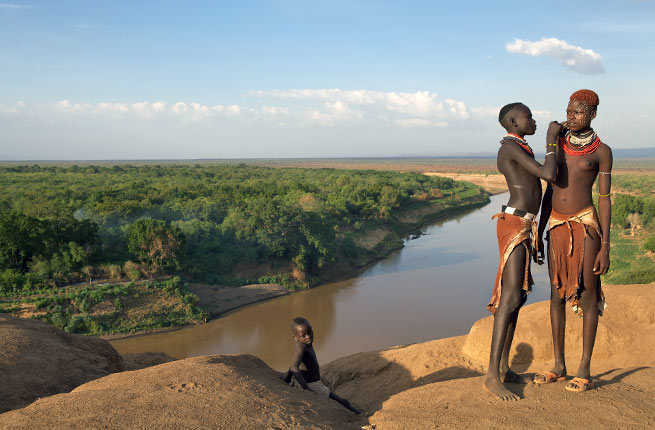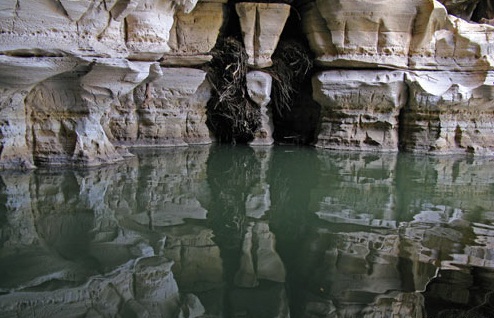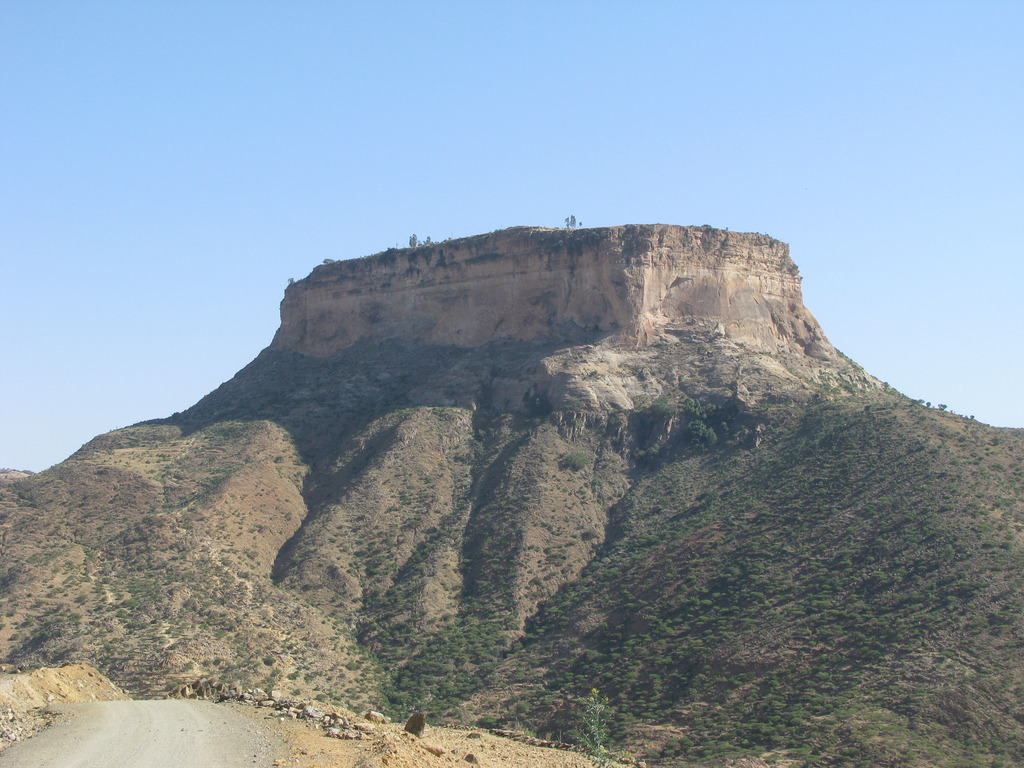22 April 2014
Buzz Ethiopia
Ethiopia’s uniqueness makes it a fascinating destination for every kind of traveler, but in particular for the traveler who wants that bit more. Ethiopia’s historic sites are extremely wide-ranging and possibly the most extensive in the whole of Sub-Saharan Africa. Experts claim that such sites are only a fraction of what Ethiopia has to offer given that a further 95% remain to be discovered and excavated.
Seven of Ethiopia’s cultural heritage sights are included in the world cultural heritage list:
These are the must visit places in Ethiopia.
1. The Simien Mountain National Park (North Gondar Zone)

Mountains of Ethiopia

The Simien Mountain is one of the major highlands of Africa, rising to the highest point in Ethiopia, Ras Dejen (4620m), which is the fourth highest peak in the continent. Although Simien is in Africa and not too far from the equator, snow and ice appear on the highest points and night temperatures often fall below zero.

The national park has three general botanical regions. The higher lands are mountain grasslands with fescue grasses as well as heathers, splendid Red Hot Pokers and Giant Lobelia.

The park was created primarily to protect the Walia Ibex, and over 1000 are said to live in the park. Also in the park are families of the unique Gelada Baboon with its scarlet ‘bleeding heart on its chest,’ and the rare Simien fox.

The Simien fox, although named after the mountains is rarely seen by the visitor. Over 50 species of birds have been reported in the Simien mountains.

Access to the park is from Debark, 101km from Gonder, where riding and pack animals may be hired. This should be arranged in advance through your local tour operator or the Office of the Wildlife Conservation Department.
2. The Rock-Hewn churches of Lalibela (North Wollo Zone)

Lalibela, 642 kilometres from Addis Ababa, is internationally-renowned for its rock-hewn churches which are sometimes called the “Eighth Wonder of the World”. Physically prised from the rock in which they stand, these monolithic churches were originally thought to have been built in the 12th century during the reign of King Lalibela, but some have been dated back to the 10th century. There are eleven churches, assembled in three groupings:

The Northern Group: Bete Medhane Alem, home to the Lalibela Cross and believed to be the largest monolithic church in the world. It is linked to Bete Maryam (possibly the oldest of the churches), Bete Golgotha (known for its arts and said to contain the tomb of King Lalibela), the Selassie Chapel and the Tomb of Adam.

The Western Group: Bete Giyorgis, said to be the most finely executed and best preserved church.
The Eastern Group: Bete Amanuel , Bete Merkorios, Bete Abba Libanos and Bete Gabriel-Rufael.

Further afield lie the monastery of Ashetan Maryam and Yimrehane Kristos church.

3. The Castles of Gondar and other monuments (Gondar)

Gondar is famous for its many medieval castles and the design and decoration of its churches. The earliest of the castles was created by Fasilidas himself and is still in such an excellent state of repair that it is possible to climb its stats all the way to the roof, which commands a breathtaking view over much of the city.

748 kilometres from Addis Ababa is the graceful city of Gondar, founded by Emperor Fasilidas in 1635. The city was Ethiopia’s capital until the reign of the would-be reforming Emperor Tewodros II, also known as Theodore. During its long years as a capital city, the settlement emerged as one of the largest and most popular cities in the realm. It was a great centre of commerce, trading with the rich lands south of the Blue Nile, as well as with Sudan to the west, and the Red Sea port of Massawa to the north-east.

Besides the famous palaces, visitors can inspect the so-called “Bathing Palace of Emperor Fasilidas” which is used for the annual Timket or Epiphany celebrations, and the abbey of the redoubtable eighteenth century Empress Menteweb at Qwesquam, in the mountains just outside Gondar.
4. Awash Lower Valley palaeontological and prehistoric sites

5. Axum historical and archaeological sites, central Tigray (Tigray Region)

Axum historical and archaeological sites, central Tigray (Tigray Region) Rightly famous for its obelisks, Axum was the capital of the Axumite kingdom – once one of the four kingdoms of the world. It was also home to the Queen of Sheba whose ruined palace and bathing pool can still be found in and near the town.

6. Valley of the Omo, palaeontological and prehistoric sites (South Omo zone)

7. Tiya pre-historical and archaeological sites, central Tigray (Tigray region)

Archaeologists and anthropologists continually claim that the oldest hominid remains (Australopithecus ramidus, a new species, 4.4 million years old) were originally discovered here in the Afar region. More recent findings by Professor Tim White from the University of California, Berkeley, suggest that the earliest ape man lived in Ethiopia 5 million years ago (Daily Telegraph, Monday 18th January 1999).
8. Jugol, Harar

For centuries, Harar has been a major commercial centre, linked by the trade routes with the rest of Ethiopia, the entire Horn of Africa, the Arabian Peninsula, and, through its ports, the outside world. Harar Jugol, the old walled city, was included in the World Heritage List in 2006 by UNESCO in recognition of its cultural heritage.[4] It is sometimes known in Arabic as “the City of Saints” (“Madinat al-Awilya”). According to UNESCO, it is “considered ‘the fourth holy city’ of Islam” with 82 mosques, three of which date from the 10th century and 102 shrines.
9. The Sof Omar Cave

Sof Omar is one of the most spectacular and extensive underground cave systems in the world. Formed by the Wabi River as it changed its course in the distant past and carved out a new channel through limestone foothills, the Sof Omar systems is an extraordinary natural phenomenon of breathtaking beauty.
The cave which is now an important Islamic Shrine was named after the saintly Sheikh Sof Omar who took refuge here many centuries ago. The cave has a religious history that predates the arrival of the Muslims in Bale – a history calculated in thousands of years.
10 . Blue Nile Falls

The River Nile, the longest river in Africa, in Ethiopia. From Lake Tana, the Blue Nile, known locally as Abbay, flows from Ethiopia to meet the white Nile in Khartoum to form the great river that gives life to Egypt and the Sudan. It has been said that the Blue Nile contributes up to 80% of the Nile’s flow. Nowhere is it more spectacular than when it thunders over the Tisisat Falls near Bahar Dar. Here millions of gallons of water cascade over the cliff face and into a gorge, creating spectacular rainbows, in one of the most awe-inspiring displays in Africa, earning its name ‘Smoking Water’. The Blue Nile falls can easily be reached from Bahar Dar and the Scenic beauty of the Blue Nile Gorge, 225KM from Addis Ababa, can be enjoyed as part of an excursion from the capital.
Lake Tana

Lake Tana, the largest lake in Ethiopia is the source of the Blue Nile from where it starts its long journey to Khartoum and on to the Mediterranean. The 37 islands that are scattered about the surface of the Lake shelter fascinating churches and monastries, some of which have histories dating back to the 13th Century. However, it should be noted that most of the religious houses are not open to women. The most interesting islands are: Birgida Mariam, Dega Estefanous, Dek, Narga, Tana Cherkos, Mitsele Fasiledes, Kebran and Debre Maryam. Kebran Gabriel is the principal monastery which can be visited by male tourists from Bahar Dar with its impressive Cathedral-like Building first built at the end of the 17th Century. Dega Estephanos, which is also closed to women, is on an island in the lake, and is reached by a very steep and winding path. Although the church is relatively new (only one hundred years old), it houses a Madonna painted in the 15th century. However, the treasury of the monastery is a prime attraction with the remains of several emperors, as well as their robes and jewels.
On the banks of the lake are many more religious houses such as Ura Kidane Mehret and Narga Selassie, many of which are open to women.

Near Gorgora, at the northern end of the lake, the Susneyos palace is a forerunner of the magnificent palaces and castles of Gonder, and dates from the reign of Emperor Susneyos. In the same area the medieval church of Debre Sina Mariam is particularly important.
A sail or cruise on Lake Tana is one of the most pleasant excursions for visitors to this region, particularly in the heart of the summer. Boats can be hired from the Marine Transport Authority in Bahir Dar. Along the lakeshore bird life, both local and migratory visitors, make this an ideal place for birdwatchers. Bird lovers will not want to miss Fasilidas island, which is especially famous as an important wetland. The whole of the lake Tana region and the Blue Nile Gorge have a wide variety of birds both endemic and visitors. The variety of habitats, from rocky crags to rain forests and important wetlands, ensure that many other different species should be spotted.
